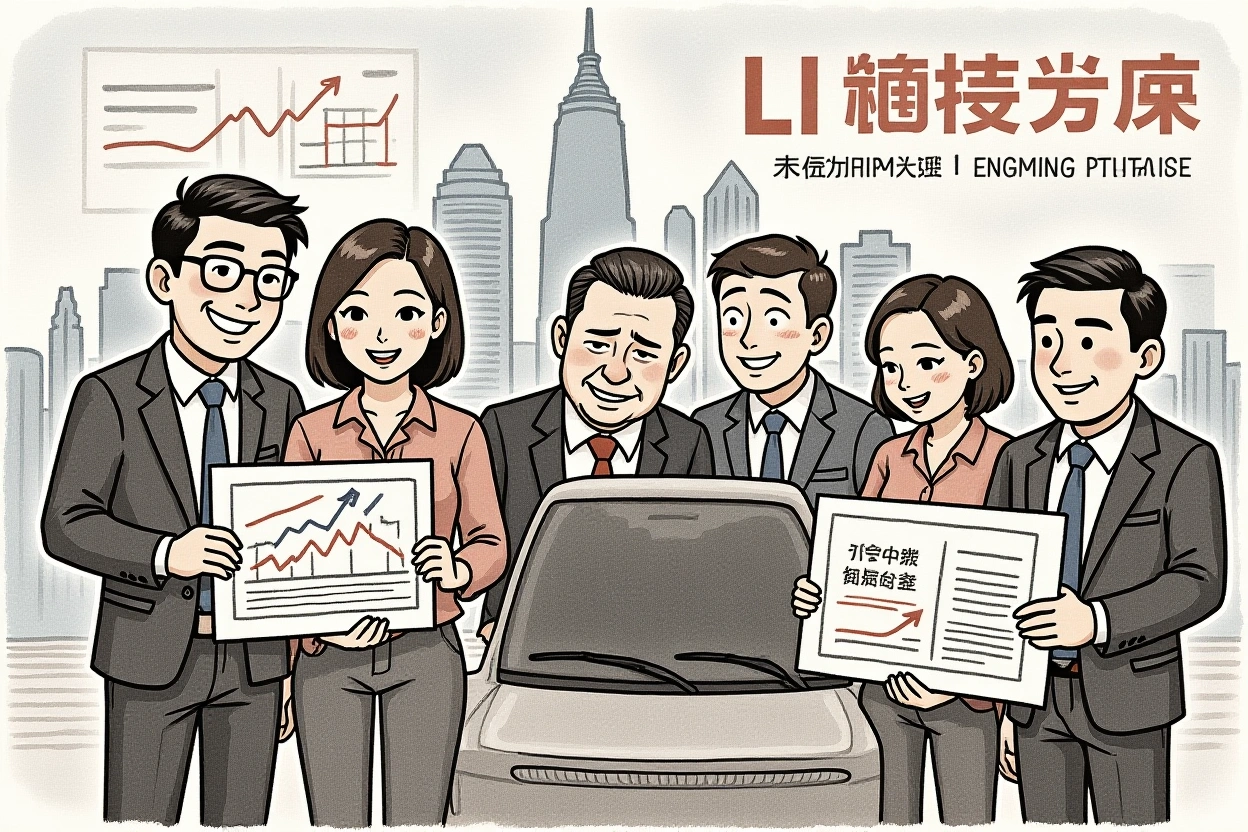– Li Auto’s Product Line President Tang Jing (汤靖) details why steel outperforms aluminum for pedestrian safety in MEGA’s compact front structure
– The electric MPV achieved China’s highest G+ safety rating despite material tradeoffs
– Steel hood allows 30% better energy absorption in tight engine compartments versus aluminum
– Engineering choice reflects growing regulatory emphasis on pedestrian protection standards
The Material Dilemma in Modern Vehicle Design
When Li Auto’s flagship MEGA electric MPV launched, automotive engineers noticed an intriguing material choice: steel hood and fenders paired with aluminum doors. This seemingly contradictory approach sparked industry discussion until Product Line President Tang Jing (汤靖) clarified the reasoning in a detailed technical explanation. The decision ultimately prioritized pedestrian protection over conventional weight-saving wisdom.
Vehicle material selection represents one of automotive engineering’s most complex equations, balancing weight reduction, cost efficiency, manufacturing feasibility, and crucially – safety performance. While aluminum reduces mass by approximately 40% compared to steel, its deformation characteristics create unique challenges for pedestrian impact safety. This becomes particularly critical in vehicles like the MEGA with its compact front architecture.
Aluminum’s Weight Advantage Meets Safety Reality
Aluminum offers compelling benefits that make it popular in premium vehicles:
– Significant weight reduction (2.5-3kg saved per door)
– Improved energy efficiency and range in EVs
– Superior corrosion resistance
– Enhanced driving dynamics through lower center of gravity
However, Tang Jing’s team discovered aluminum’s limitations during MEGA’s development phase. While they retained aluminum for the four doors and rear hatch, pedestrian impact simulations revealed alarming results with an aluminum hood. The material’s lower ductility required nearly 50% more deformation space to adequately protect a pedestrian’s head during impact – space that simply didn’t exist in MEGA’s tightly packaged front end.
Decoding Pedestrian Protection Standards
The China Insurance Automotive Safety Index (C-IASI) sets rigorous pedestrian protection requirements, with its G+ rating representing the highest achievement level. These standards evaluate how vehicle designs mitigate injury risks through:
– Head impact criteria (HIC) measurements
– Leg impact protection
– Upper body kinematics during collision
Automakers worldwide face tightening regulations, with Euro NCAP planning 40% stricter pedestrian safety requirements by 2026. For Li Auto, achieving the maximum G+ rating wasn’t optional – it represented both ethical responsibility and competitive necessity in China’s premium EV segment.
Engineering for the Unavoidable Impact
Unlike occupant protection which focuses on preserving survival space, pedestrian protection requires controlled energy absorption. Steel outperforms aluminum in three key aspects critical to MEGA’s design:
1. Greater ductility: Steel can deform up to 20% more before fracturing
2. Superior energy absorption per unit volume
3. More predictable collapse behavior across temperature variations
These characteristics proved essential in MEGA’s space-constrained front architecture where the distance between hood surface and underlying components measured just 8-12cm – far below the 15-20cm clearance typically needed for aluminum hoods to achieve equivalent protection.
MEGA’s Front-End Packaging Challenges
Electric MPVs face unique packaging constraints that influenced Li Auto’s material decision. The MEGA combines:
– An exceptionally short hood profile for aerodynamic efficiency
– High-voltage components concentrated in the front compartment
– Structural reinforcements for battery protection
– Cooling systems for battery thermal management
This created what Tang Jing described as a ‘component-dense environment’ where traditional aluminum hood solutions couldn’t provide adequate deformation space. Computer simulations showed steel could achieve the required 65-70mm of controlled collapse within the available clearance – a physical impossibility with aluminum without major vehicle architecture changes.
The Physics of Impact Dynamics
During pedestrian impact, vehicle speed directly influences injury outcomes:
| Impact Speed | Aluminum Hood Injury Risk | Steel Hood Injury Risk |
|---|---|---|
| 30 km/h | Moderate concussion likely | Mild concussion possible |
| 40 km/h | Severe head trauma probable | Moderate concussion likely |
| 50 km/h | 85%+ fatal head injury | 70% fatal head injury |
*Based on C-IASI test protocols
Steel’s superior energy absorption provides critical milliseconds of deceleration that reduce peak impact forces by 15-20% compared to aluminum in equivalent installations. This directly translates to reduced traumatic brain injury risks according to Journal of Safety Research studies.
The Weight-Safety Tradeoff Analysis
Li Auto’s engineers conducted exhaustive tradeoff studies before finalizing materials. Their calculations revealed:
– Aluminum hood would save approximately 4.2kg
– Equivalent safety performance would require 14cm clearance (vs available 11cm)
– Achieving clearance would increase front overhang by 15%, harming aerodynamics
– Structural modifications would add 7kg – negating weight savings
Ultimately, steel provided the only path to achieving their safety targets without compromising other vehicle attributes. The material choice reflects a broader industry shift toward multi-material strategies where each component uses the optimal material for its specific function rather than blanket material applications.
Manufacturing and Cost Considerations
Contrary to popular perception, the steel hood decision wasn’t primarily cost-driven. While high-strength steel costs approximately 60% less per kilogram than automotive-grade aluminum, the manufacturing differences create near-equivalent system costs when considering:
– Aluminum’s simpler forming process
– Reduced corrosion treatment requirements
– Lower painting complexity
Li Auto’s choice instead prioritized engineering integrity over either cost savings or marketing advantages. This aligns with their brand positioning around family safety – a message consistently emphasized by CEO Li Xiang (李想) in product communications.
Validating the Safety Performance
The MEGA’s pedestrian protection capabilities underwent rigorous validation through:
– 200+ computer simulations of impact scenarios
– 47 physical tests with sensor-equipped crash dummies
– Component-level material fatigue testing
– Environmental performance validation (-30°C to +60°C)
These tests culminated in the MEGA achieving the highest possible G+ rating in C-IASI’s pedestrian protection assessment – a rating shared by fewer than 15% of vehicles tested in 2023. Independent test data showed the steel hood reduced Head Injury Criterion (HIC) measurements by 22% compared to aluminum prototypes.
Industry Reactions and Implications
Automotive safety experts have praised Li Auto’s transparency in explaining material decisions. Professor David Zhao (赵福全) of Tongji University noted: ‘This case study demonstrates how safety must drive material choices rather than chasing weight reduction metrics indiscriminately.’ The approach may influence other Chinese EV makers facing similar packaging challenges with their short-nose electric platforms.
Future Material Innovation Pathways
While steel currently offers the optimal solution for MEGA’s specific requirements, material science continues evolving. Emerging solutions that may change future equations include:
– Third-generation advanced high-strength steels (3G-AHSS) offering 25% better specific energy absorption
– Hybrid material systems combining aluminum carriers with steel outer panels
– Active hood systems that lift upon impact detection
– Composite materials with tunable deformation properties
Li Auto has patented several material applications that could appear in future models. Their Material Choice Matrix methodology – balancing safety, weight, cost, and manufacturability – provides a template for intelligent material selection as vehicles become increasingly complex.
Tang Jing’s explanation provides valuable insights into modern vehicle development priorities. Safety considerations increasingly override traditional automotive engineering conventions as regulations evolve and consumer awareness grows. The MEGA’s steel hood represents more than a material choice – it signifies how leading manufacturers now approach vehicle design through a holistic safety lens.
When evaluating your next vehicle purchase, look beyond superficial specifications and investigate the safety philosophy embedded in its engineering. Visit the China Insurance Automotive Safety Index website to compare pedestrian protection ratings across models, because sometimes the most important innovations happen beneath the surface.




